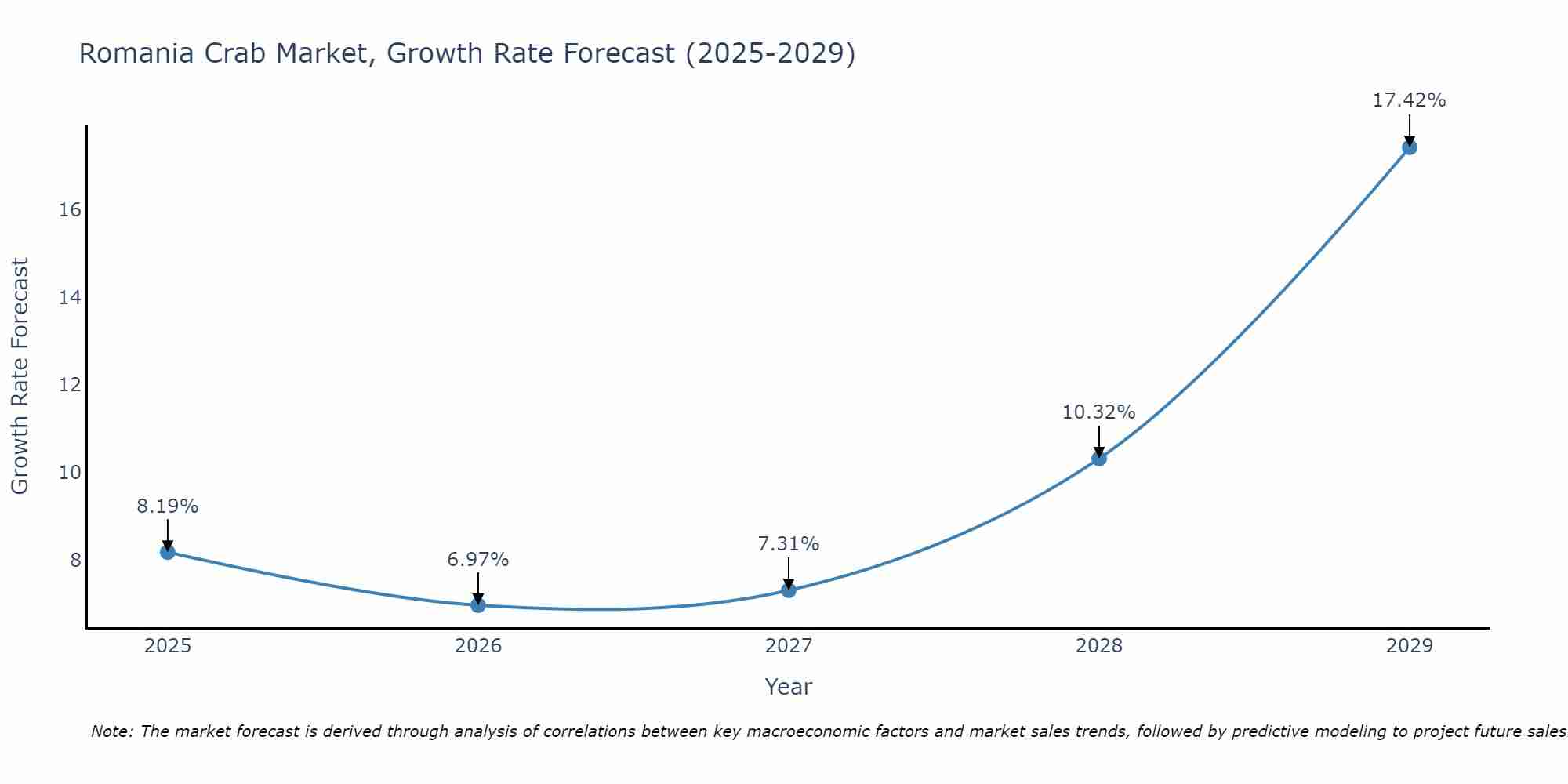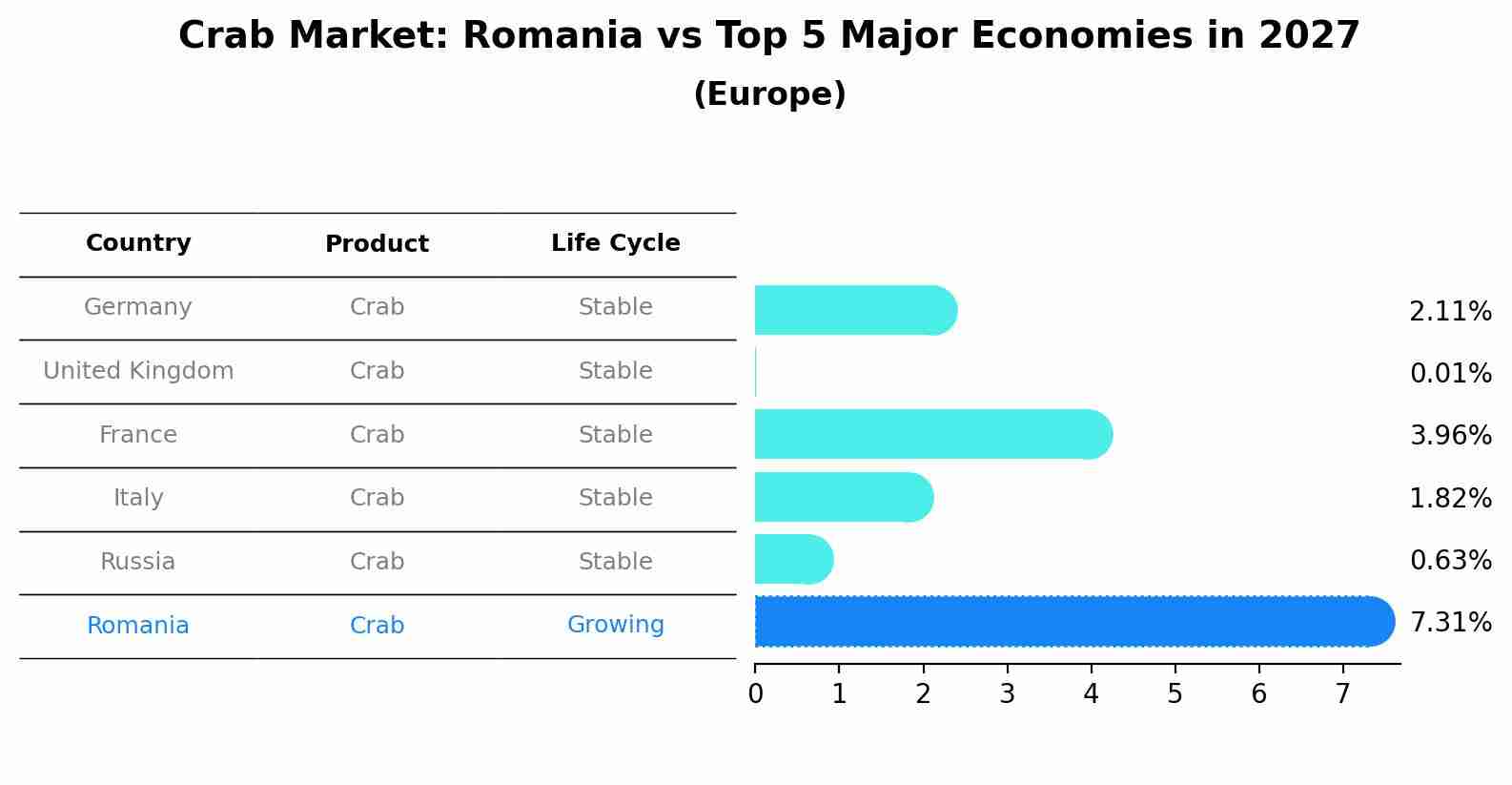Romania Crab Market Outlook | Companies, Value, Industry, Trends, Analysis, Growth, Share, COVID-19 IMPACT, Size, Forecast & Revenue
| Product Code: ETC088837 | Publication Date: Jun 2021 | Updated Date: Jun 2025 | Product Type: Report | |
| Publisher: 6Wresearch | Author: Shubham Deep | No. of Pages: 70 | No. of Figures: 35 | No. of Tables: 5 |
Romania Crab Market Size Growth Rate
The Romania Crab Market is projected to witness mixed growth rate patterns during 2025 to 2029. Commencing at 8.19% in 2025, growth builds up to 17.42% by 2029.

Crab Market: Romania vs Top 5 Major Economies in 2027 (Europe)
In the Europe region, the Crab market in Romania is projected to expand at a growing growth rate of 7.31% by 2027. The largest economy is Germany, followed by United Kingdom, France, Italy and Russia.

Romania Crab Market Overview
The Romania crab market is relatively small compared to other seafood markets, with a focus primarily on imports rather than domestic production. The demand for crab in Romania is driven largely by the growing popularity of seafood consumption among the population and the influence of international cuisine trends. The market offers a variety of crab species, including blue crab, snow crab, and king crab, with imported products mainly sourced from countries like Norway, Canada, and the United States. While the market is not as mature as in some other countries, there is a noticeable increase in the availability of crab products in supermarkets and seafood restaurants across Romania, indicating a potential for future growth as consumer preferences continue to evolve towards healthier and more diverse dining options.
Romania Crab Market Trends
In the Romania crab market, there is a growing demand for high-quality and sustainably sourced crab products. Consumers are increasingly seeking out ethically and responsibly sourced seafood, leading to a trend towards transparency in the supply chain. Additionally, there is a rising interest in innovative crab products and flavors, driving the market towards diversification and premiumization. Health-conscious consumers are also looking for crab products that are low in fat and high in protein, aligning with the overall trend towards healthier food options. The market is also seeing an increase in online sales of crab products, as e-commerce platforms offer convenience and a wider selection to consumers. Overall, the Romania crab market is evolving to meet the changing preferences and demands of consumers for sustainable, high-quality, and innovative crab products.
Romania Crab Market Challenges
In the Romania crab market, some of the key challenges faced include limited availability of locally sourced crabs, leading to a heavy reliance on imported crabs which can drive up costs for consumers. Additionally, there may be issues with inconsistent quality and freshness of the imported crabs, impacting the overall satisfaction of customers. Lack of awareness and demand for crab dishes in Romanian cuisine also poses a challenge, as consumers may be more inclined to choose familiar seafood options. Furthermore, regulatory hurdles and compliance with international standards for crab imports can create barriers for market players. Overall, building a sustainable and thriving crab market in Romania requires addressing these challenges through strategic sourcing, quality control measures, consumer education, and regulatory alignment.
Romania Crab Market Investment Opportunities
The Romania crab market presents promising investment opportunities due to the increasing demand for seafood in the region. With the growing popularity of crab dishes among consumers, there is a strong market potential for both domestic consumption and export opportunities. Investing in crab farming operations or establishing partnerships with local seafood suppliers can be profitable ventures in Romania. Additionally, there is potential for value-added products such as canned crab meat or crab-based snacks to cater to different market segments. As the market continues to evolve and demand for high-quality seafood products rises, investors in the Romania crab market could benefit from tapping into this growing industry.
Romania Crab Market Government Policy
The Romanian government has put in place regulations to manage the crab market effectively. This includes a ban on the import and sale of live Chinese mitten crabs due to their invasive nature and potential impact on local ecosystems. Additionally, there are strict guidelines on the harvesting and processing of crabs to ensure sustainability and quality control. The government also provides subsidies and support to local crab farmers to encourage domestic production and reduce reliance on imports. Overall, the policies aim to protect the environment, promote local industry, and maintain a balance between supply and demand in the Romanian crab market.
Romania Crab Market Future Outlook
The future outlook for the Romania Crab Market appears to be promising, with potential for growth driven by increasing demand for seafood products in the country. As consumer preferences shift towards healthier and more diverse food options, there is a growing interest in crab as a delicious and nutritious choice. Additionally, the growing popularity of seafood in Romanian cuisine and the expansion of dining options offering crab dishes are expected to further drive market growth. However, the market may face challenges related to sustainability and environmental concerns, which could impact the supply chain and pricing dynamics. Overall, with the right strategies in place to address these challenges and capitalize on market trends, the Romania Crab Market is poised for expansion in the coming years.
Key Highlights of the Report:
- Romania Crab Market Outlook
- Market Size of Romania Crab Market, 2021
- Forecast of Romania Crab Market, 2027
- Historical Data and Forecast of Romania Crab Revenues & Volume for the Period 2018 - 2027
- Romania Crab Market Trend Evolution
- Romania Crab Market Drivers and Challenges
- Romania Crab Price Trends
- Romania Crab Porter's Five Forces
- Romania Crab Industry Life Cycle
- Historical Data and Forecast of Romania Crab Market Revenues & Volume By Type for the Period 2018 - 2027
- Historical Data and Forecast of Romania Crab Market Revenues & Volume By Blue Crab for the Period 2018 - 2027
- Historical Data and Forecast of Romania Crab Market Revenues & Volume By Chinese Mitten Crab for the Period 2018 - 2027
- Historical Data and Forecast of Romania Crab Market Revenues & Volume By Gazami Crab for the Period 2018 - 2027
- Historical Data and Forecast of Romania Crab Market Revenues & Volume By Others for the Period 2018 - 2027
- Historical Data and Forecast of Romania Crab Market Revenues & Volume By Form for the Period 2018 - 2027
- Historical Data and Forecast of Romania Crab Market Revenues & Volume By Frozen for the Period 2018 - 2027
- Historical Data and Forecast of Romania Crab Market Revenues & Volume By Canned for the Period 2018 - 2027
- Historical Data and Forecast of Romania Crab Market Revenues & Volume By Others for the Period 2018 - 2027
- Romania Crab Import Export Trade Statistics
- Market Opportunity Assessment By Type
- Market Opportunity Assessment By Form
- Romania Crab Top Companies Market Share
- Romania Crab Competitive Benchmarking By Technical and Operational Parameters
- Romania Crab Company Profiles
- Romania Crab Key Strategic Recommendations
Frequently Asked Questions About the Market Study (FAQs):
1 Executive Summary |
2 Introduction |
2.1 Key Highlights of the Report |
2.2 Report Description |
2.3 Market Scope & Segmentation |
2.4 Research Methodology |
2.5 Assumptions |
3 Romania Crab Market Overview |
3.1 Romania Country Macro Economic Indicators |
3.2 Romania Crab Market Revenues & Volume, 2021 & 2027F |
3.3 Romania Crab Market - Industry Life Cycle |
3.4 Romania Crab Market - Porter's Five Forces |
3.5 Romania Crab Market Revenues & Volume Share, By Type, 2021 & 2027F |
3.6 Romania Crab Market Revenues & Volume Share, By Form, 2021 & 2027F |
4 Romania Crab Market Dynamics |
4.1 Impact Analysis |
4.2 Market Drivers |
4.3 Market Restraints |
5 Romania Crab Market Trends |
6 Romania Crab Market, By Types |
6.1 Romania Crab Market, By Type |
6.1.1 Overview and Analysis |
6.1.2 Romania Crab Market Revenues & Volume, By Type, 2018 - 2027F |
6.1.3 Romania Crab Market Revenues & Volume, By Blue Crab, 2018 - 2027F |
6.1.4 Romania Crab Market Revenues & Volume, By Chinese Mitten Crab, 2018 - 2027F |
6.1.5 Romania Crab Market Revenues & Volume, By Gazami Crab, 2018 - 2027F |
6.1.6 Romania Crab Market Revenues & Volume, By Others, 2018 - 2027F |
6.2 Romania Crab Market, By Form |
6.2.1 Overview and Analysis |
6.2.2 Romania Crab Market Revenues & Volume, By Frozen, 2018 - 2027F |
6.2.3 Romania Crab Market Revenues & Volume, By Canned, 2018 - 2027F |
6.2.4 Romania Crab Market Revenues & Volume, By Others, 2018 - 2027F |
7 Romania Crab Market Import-Export Trade Statistics |
7.1 Romania Crab Market Export to Major Countries |
7.2 Romania Crab Market Imports from Major Countries |
8 Romania Crab Market Key Performance Indicators |
9 Romania Crab Market - Opportunity Assessment |
9.1 Romania Crab Market Opportunity Assessment, By Type, 2021 & 2027F |
9.2 Romania Crab Market Opportunity Assessment, By Form, 2021 & 2027F |
10 Romania Crab Market - Competitive Landscape |
10.1 Romania Crab Market Revenue Share, By Companies, 2021 |
10.2 Romania Crab Market Competitive Benchmarking, By Operating and Technical Parameters |
11 Company Profiles |
12 Recommendations |
13 Disclaimer |
- Single User License$ 1,995
- Department License$ 2,400
- Site License$ 3,120
- Global License$ 3,795
Search
Thought Leadership and Analyst Meet
Our Clients
Related Reports
- Canada Oil and Gas Market (2026-2032) | Share, Segmentation, Value, Industry, Trends, Forecast, Analysis, Size & Revenue, Growth, Competitive Landscape, Outlook, Companies
- Germany Breakfast Food Market (2026-2032) | Industry, Share, Growth, Size, Companies, Value, Analysis, Revenue, Trends, Forecast & Outlook
- Australia Briquette Market (2025-2031) | Growth, Size, Revenue, Forecast, Analysis, Trends, Value, Share, Industry & Companies
- Vietnam System Integrator Market (2025-2031) | Size, Companies, Analysis, Industry, Value, Forecast, Growth, Trends, Revenue & Share
- ASEAN and Thailand Brain Health Supplements Market (2025-2031) | Strategy, Consumer Insights, Analysis, Investment Trends, Opportunities, Growth, Size, Share, Industry, Revenue, Segments, Value, Segmentation, Supply, Forecast, Restraints, Outlook, Competition, Drivers, Trends, Demand, Pricing Analysis, Competitive, Strategic Insights, Companies, Challenges
- ASEAN Bearings Market (2025-2031) | Strategy, Consumer Insights, Analysis, Investment Trends, Opportunities, Growth, Size, Share, Industry, Revenue, Segments, Value, Segmentation, Supply, Forecast, Restraints, Outlook, Competition, Drivers, Trends, Demand, Pricing Analysis, Competitive, Strategic Insights, Companies, Challenges
- Europe Flooring Market (2025-2031) | Outlook, Share, Industry, Trends, Forecast, Companies, Revenue, Size, Analysis, Growth & Value
- Saudi Arabia Manlift Market (2025-2031) | Outlook, Size, Growth, Trends, Companies, Industry, Revenue, Value, Share, Forecast & Analysis
- Uganda Excavator, Crane, and Wheel Loaders Market (2025-2031) | Strategy, Consumer Insights, Analysis, Investment Trends, Opportunities, Growth, Size, Share, Industry, Revenue, Segments, Value, Segmentation, Supply, Forecast, Restraints, Outlook, Competition, Drivers, Trends, Demand, Pricing Analysis, Competitive, Strategic Insights, Companies, Challenges
- Rwanda Excavator, Crane, and Wheel Loaders Market (2025-2031) | Strategy, Consumer Insights, Analysis, Investment Trends, Opportunities, Growth, Size, Share, Industry, Revenue, Segments, Value, Segmentation, Supply, Forecast, Restraints, Outlook, Competition, Drivers, Trends, Demand, Pricing Analysis, Competitive, Strategic Insights, Companies, Challenges
Industry Events and Analyst Meet
Whitepaper
- Middle East & Africa Commercial Security Market Click here to view more.
- Middle East & Africa Fire Safety Systems & Equipment Market Click here to view more.
- GCC Drone Market Click here to view more.
- Middle East Lighting Fixture Market Click here to view more.
- GCC Physical & Perimeter Security Market Click here to view more.
6WResearch In News
- Doha a strategic location for EV manufacturing hub: IPA Qatar
- Demand for luxury TVs surging in the GCC, says Samsung
- Empowering Growth: The Thriving Journey of Bangladesh’s Cable Industry
- Demand for luxury TVs surging in the GCC, says Samsung
- Video call with a traditional healer? Once unthinkable, it’s now common in South Africa
- Intelligent Buildings To Smooth GCC’s Path To Net Zero


















